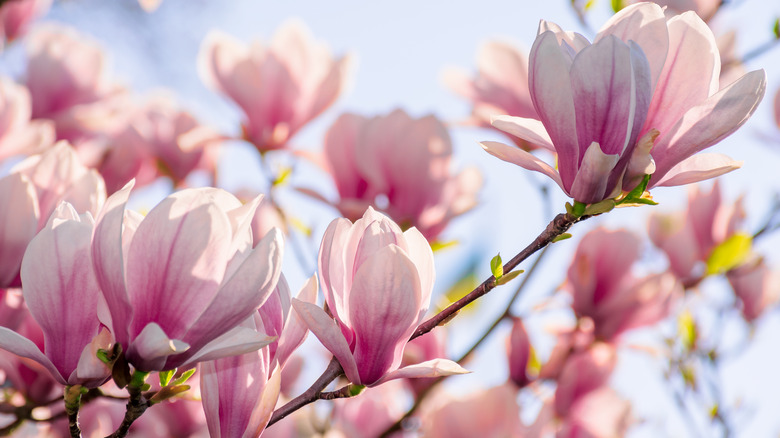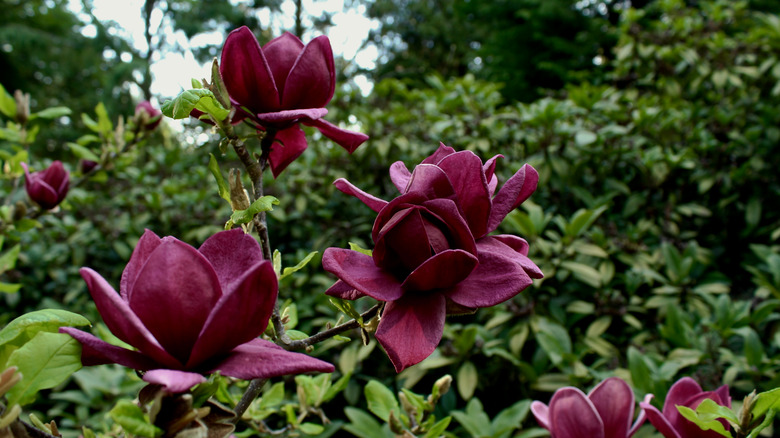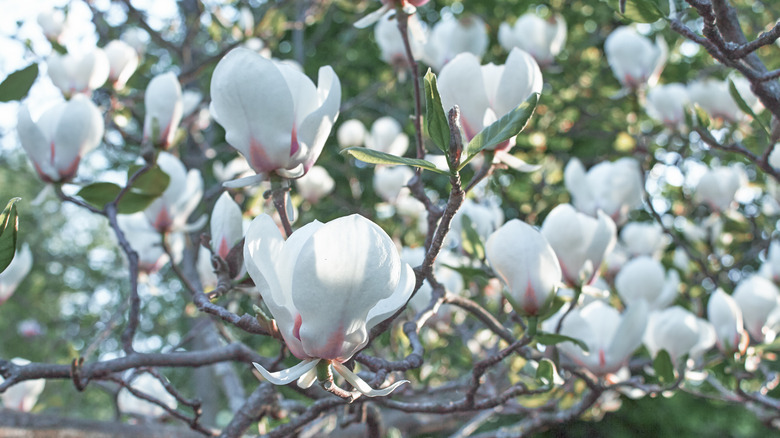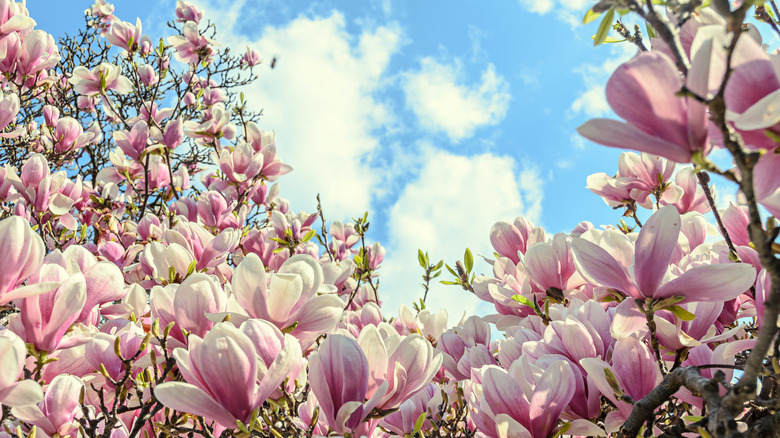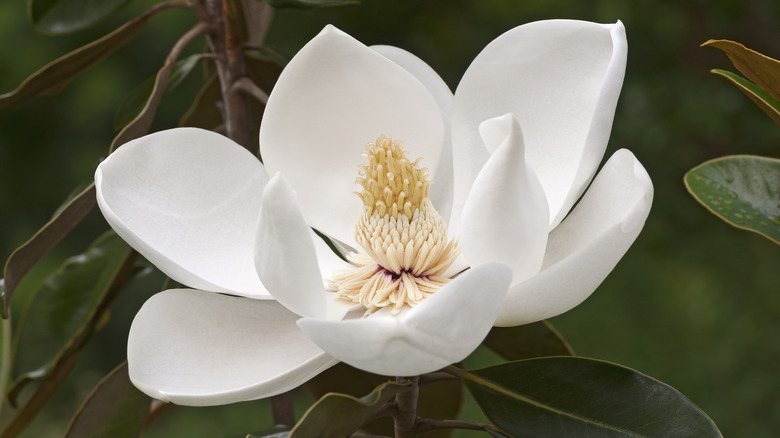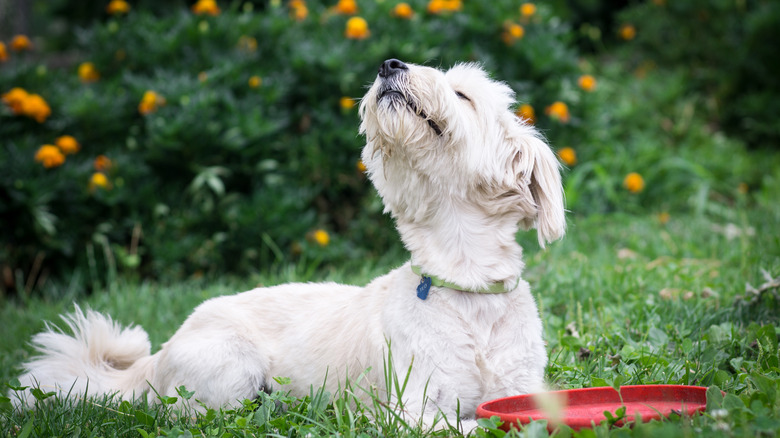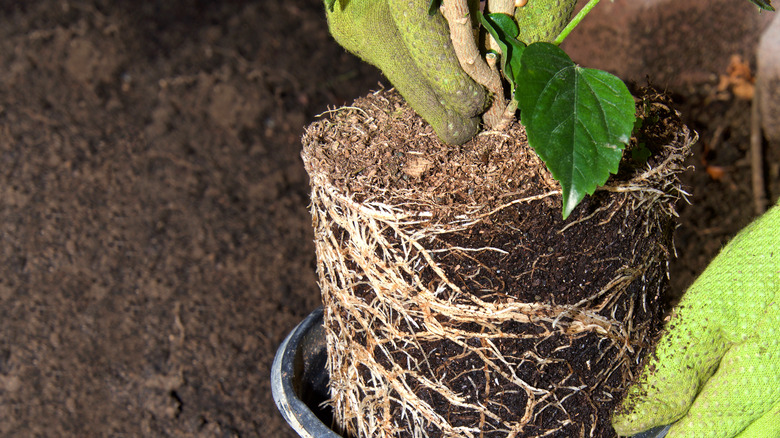How To Grow And Care For Magnolia Trees
The Magnoliaceae (also known as the magnolia) is one of the oldest and most popular plants folks tend to grow in their gardens. They range from 15-foot shrubs to over 80 feet tall, and their leaf sizes can grow from 5 inches to 8 inches long and 5 inches wide. Considering their range in height, Magnolia trees can be one of the most hardy plants to grow, though it can take years for them to bloom. They bloom in a variety of colors such as pink, purple, white and even yellow.
Magnolias have been around for over 100 million years, before even bees existed, according to Garden Design. Normally the bees are the ones to take pollen from flowers to use, but beetles take the pollen from magnolia trees as their source of food and are relied on for pollination. Magnolia Officinalis bark has also been used in Chinese medicine to help care for lung health and manage anxiety, according to House Beautiful.
How to use magnolia trees in garden
With a grand variety of magnolias to choose from, there's always one that could make a home in your garden. Magnolias can be used to spruce up any space with their bright colors and different sizes. The trees that grow up to 12 feet high, such as the Fairy Magnolia, can be used as a hedge to create more privacy for your home, according to Architectural Digest. Magnolias can also be planted straight into the ground if you have a plan on how you'd like your garden to look, or they can be planted in containers so that you're able to rearrange them as much as you'd like. They can even be displayed indoors in the kitchen to add a pop of color or on the porch by the door so that it's the first thing someone sees.
If you solely have solid green plants in your backyard, the Felix Magnolia and the Burgundy Star Magnolia could be great add-ons to brighten up the garden with their deep pink and purple petals. Magnolias are one of the most versatile plants used to decorate even the smallest spaces.
How to grow magnolia trees
To get started on planting your magnolia tree, you'll need well-draining soil that is slightly acidic to neutral, organic compost and wood chips to use as gardening mulch (any mulch works). You can also use some peat moss or sand mixed in with your compost to keep the moisture level balanced.
According to Better Homes & Gardens, start by finding a spot where you're going to plant the tree tailored to your climate. If you live in an area where it's hotter, place the tree in a shadier area, and if you live somewhere cooler, place the tree in a sunnier area with partial shade. Dig a hole about 1.5 times the width of the root of the tree. Place the tree in the hole making sure the top root is leveled and exposed at the top of the hole. Fill the hole with organic compost about halfway making sure the tree is standing straight. Then, fill that same half-filled hole with water, let it drain, and fill the rest of the hole with soil while keeping the top root still exposed. Cover the top root and surrounding area with a few inches of mulch to keep the soil moist.
How to care for magnolia trees
Even though magnolia trees take a few years to grow, they are disease and pest resistant while also easy to maintain and care for. After you've planted your tree, regularly water it in order to keep the soil moist until it's well established. Once your tree starts growing you can hold back on watering it a little.
When the first batch of flowers starts to bloom, you can start pruning to remove damaged branches. You don't want to heavily prune your tree because it could cause damage to it, according to Better Homes & Gardens. Pruning only needs to be done once the tree is in full bloom, which depending when you plant your tree could be late spring or early summer. Some varieties of magnolias may need fertilizer if they're not growing properly; if this happens you can use 20-5-10 fertilizer, as noted by The Spruce. If your magnolias are growing at a perfect rate there's no need for the fertilizer.
Varieties of magnolia trees
With over 200 species, magnolia plants are evergreen and deciduous, located mostly in the south. They extend from eastern North Carolina, south along the Atlantic Coast, all the way to Texas. They also reside in other areas such as Mexico, and in countries in Central America and East and Southeast Asia. Magnolias can be grown anywhere with the right climate and care. A few common species are southern magnolia, sweetbay magnolia, cucumber tree and saucer magnolia.
The Spruce ranked these magnolias as some of the top species:
-
Magnolia salicifolia: They have leaves similar to those of a willow tree except they're a bit wider and bloom white flowers.
-
Magnolia macrophylla: This plant grows big green leaves up to 32 inches long and flower petals up to 10 inches wide.
-
Magnolia ashei: Sometimes considered a subspecies of the magnolia macrophylla due to its 2 feet long green leaves.
-
Magnolia liliiflora: A smaller species which can grow as trees or shrubs.
-
Magnolia kubos: Known as the Japanese magnolia that forms multiple trunks which gets pruned down to one trunk to look like a tree.
Are magnolia trees toxic?
Some plants can be toxic for some animals, but magnolia trees are not toxic to be around. According to The Nest, magnolias aren't poisonous to cats or dogs, so they're allowed to roam freely around the tree if they'd like. Cats can climb and pick at the bark or leaves without being harmed; dogs can eat a couple seeds and be safe from it — although if they ingest too much of the leaves, bark, or seeds they could get sick. If your pet shows signs of vomiting, diarrhea, or lack of appetite call your vet to get some help.
It's also best to keep your furry friends away from the magnolia trees when they've been sprayed with any chemicals such as fertilizer, pesticide, or herbicide. If they ingest any part of the tree that has chemicals on it, they could get severely sick. It's best to let the rain or sprinklers wash out the chemicals for a couple of days before letting your pets near the magnolias.
How to repot magnolia trees
Repotting your magnolia plant if it lives in a container could make it live longer. When the plant's roots begin to come out of the holes from the container or the soil isn't staying moist from the water it's time to repot it, according to SFGate. Repotting the plant takes care, patience, and maybe a friend because of how difficult it could be to take out.
Start by grabbing the base of the plant with one hand and the top of the container with the other; twist the trunk, pulling it out of the container. If the tree doesn't come out, either hit the container against a hard surface to loosen it or ask a friend for help. Once the tree is out, prune the roots about 1/3 from the root ball and disinfect with any household disinfectant. Cut slits about 1/3 up the roots and disinfect them again.
Next, clean out the new container and fill it with an inch of soil before placing the tree inside. If the top of your tree is too big to where it's falling over, place it in a larger container. Place the tree in the soil and fill the rest of the space with soil. Then, water the plant thoroughly until it drains out completely and stays moist. Finally, place the container on a wooden rack about 2 inches off the ground to allow the draining water to run freely.
